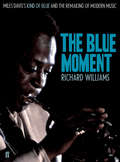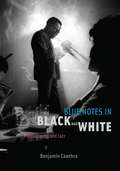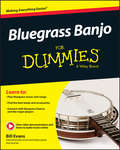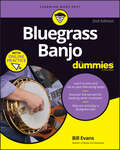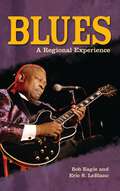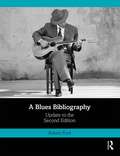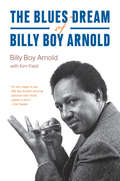- Table View
- List View
The Blue Moment: Miles Davis's Kind of Blue and the Remaking of Modern Music
by Richard Williams'It is the most singular of sounds, yet among the most ubiquitous. It is the sound of isolation that has sold itself to millions.'Miles Davis's Kind of Blue is the best selling piece of music in the history of jazz, and for many listeners among the most haunting in all of twentieth-century music. It is also, notoriously, the only jazz album many people own. Recorded in 1959 (in nine miraculous hours), there has been nothing like it since. Its atmosphere - slow, dark, meditative, luminous - became all-pervasive for a generation, and has remained the epitome of melancholy coolness ever since.Richard Williams has written a history of the album which for once does not rip it out of its wider cultural context. He evokes the essence of the music - identifying the qualities that make it so uniquely appealing - while making effortless connections to painting, literature, philosophy and poetry. This makes for an elegant, graceful and beautifully-written narrative.
Blue Notes in Black and White: Photography and Jazz
by Benjamin CawthraMiles Davis, supremely cool behind his shades. Billie Holiday, eyes closed and head tilted back in full cry. John Coltrane, one hand behind his neck and a finger held pensively to his lips. These iconic images have captivated jazz fans nearly as much as the music has. Jazz photographs are visual landmarks in American history, acting as both a reflection and a vital part of African American culture in a time of immense upheaval, conflict, and celebration. Charting the development of jazz photography from the swing era of the 1930s to the rise of black nationalism in the ’60s, Blue Notes in Black and White is the first of its kind: a fascinating account of the partnership between two of the twentieth century’s most innovative art forms. Benjamin Cawthra introduces us to the great jazz photographers—including Gjon Mili, William Gottlieb, Herman Leonard, Francis Wolff, Roy DeCarava, and William Claxton—and their struggles, hustles, styles, and creative visions. We also meet their legendary subjects, such as Duke Ellington, sweating through a late-night jam session for the troops during World War II, and Dizzy Gillespie, stylish in beret, glasses, and goatee. Cawthra shows us the connections between the photographers, art directors, editors, and record producers who crafted a look for jazz that would sell magazines and albums. And on the other side of the lens, he explores how the musicians shaped their public images to further their own financial and political goals. This mixture of art, commerce, and racial politics resulted in a rich visual legacy that is vividly on display in Blue Notes in Black and White. Beyond illuminating the aesthetic power of these images, Cawthra ultimately shows how jazz and its imagery served a crucial function in the struggle for civil rights, making African Americans proudly, powerfully visible.
Bluegrass Banjo For Dummies
by Bill EvansStart picking the five-string banjo like a pro with this definitive guide to bluegrass banjo! Whether you’re an absolute beginner or an experienced player, Bluegrass Banjo For Dummies gets you started off the right way and is your road map for mastering today’s most popular traditional and contemporary banjo picking styles. Online audio and video clips combine with the book’s clear step-by-step instructions to provide the most complete – and fun - banjo instruction experience available anywhere! Bluegrass banjo has never been more popular and is heard today not only in country and folk music, but in jazz, rock and country styles. Bluegrass Banjo For Dummies provides everything you need to know to play just about any kind of music on the five-string banjo by getting you started with the roll patterns essential to Scruggs style picking. You’ll then add left-hand techniques such as slides, hammer-ons and pull-offs, play great sounding licks and perform classic tunes like “Cripple Creek” and “Old Joe Clark.” You’ll navigate up the neck on the instrument as well as learn the essential skills you need to play with others in jam sessions and in bands. You’ll even tackle contemporary banjo styles using melodic and single-string scales and picking techniques. Choose a banjo and accessories that are just right for you and your budget. Put on your fingerpicks, find your optimal hand position and start playing with the help of online audio and video. Explore the fingerboard using melodic and single-string playing styles. Accompany others in different keys with roll patterns and chord vamping techniques. Keep your banjo sounding its best with practical and easy set up tips. Bill Evans is one of the world’s most popular banjo players and teachers, with over forty years of professional experience. In Bluegrass Banjo For Dummies, he shares the tips, secrets and shortcuts that have helped thousands of musicians, including many of today’s top young professionals, to become great banjo players.
Bluegrass Banjo For Dummies
by Bill EvansStart picking the five-string banjo like a pro with this definitive guide to bluegrass banjo! Whether you’re an absolute beginner or an experienced player, Bluegrass Banjo For Dummies gets you started off the right way and is your road map for mastering today’s most popular traditional and contemporary banjo picking styles. Online audio and video clips combine with the book’s clear step-by-step instructions to provide the most complete – and fun - banjo instruction experience available anywhere! Bluegrass banjo has never been more popular and is heard today not only in country and folk music, but in jazz, rock and country styles. Bluegrass Banjo For Dummies provides everything you need to know to play just about any kind of music on the five-string banjo by getting you started with the roll patterns essential to Scruggs style picking. You’ll then add left-hand techniques such as slides, hammer-ons and pull-offs, play great sounding licks and perform classic tunes like “Cripple Creek” and “Old Joe Clark.” You’ll navigate up the neck on the instrument as well as learn the essential skills you need to play with others in jam sessions and in bands. You’ll even tackle contemporary banjo styles using melodic and single-string scales and picking techniques. Choose a banjo and accessories that are just right for you and your budget. Put on your fingerpicks, find your optimal hand position and start playing with the help of online audio and video. Explore the fingerboard using melodic and single-string playing styles. Accompany others in different keys with roll patterns and chord vamping techniques. Keep your banjo sounding its best with practical and easy set up tips. Bill Evans is one of the world’s most popular banjo players and teachers, with over forty years of professional experience. In Bluegrass Banjo For Dummies, he shares the tips, secrets and shortcuts that have helped thousands of musicians, including many of today’s top young professionals, to become great banjo players.
Bluegrass Banjo For Dummies: Book + Online Video & Audio Instruction
by Bill EvansPick and roll your way through bluegrass banjo basics The banjo nearly defines the bluegrass sound, and you&’ll be playing your own favorite tunes—or maybe writing some new ones—with the help of this book. Bluegrass Banjo For Dummies is the place to start if you&’re ready to start learning banjo or upgrade your skills to play in the bluegrass style. Written by an expert musician and educator, this book makes it easy to start plucking your 5-string banjo using common bluegrass techniques. You&’ll also have access to over 100 online audio files, and 35 video lessons, so you can see and hear the techniques in practice. This book serves as your first step to becoming a bluegrass banjo player, even if you&’re completely new to playing musical instruments. Choose the right banjo, pick up the basics, learn classic banjo licks, and more—the easy way. Learn how to read banjo tablature and perform on a five-string banjo Get insight on playing as part of a bluegrass combo band Practice with classic bluegrass tunes and banjo licks Create banjo solos that will wow your audiencesThis friendly For Dummies guide is great for fledgling banjo players interested in the bluegrass style. Whether or not you already play another instrument, you&’ll pick up the banjo basics you can show off at your next local bluegrass festival.
Bluegrass Banjo For Dummies: Book + Online Video & Audio Instruction
by William J. EvansPick and roll your way through bluegrass banjo basics The banjo nearly defines the bluegrass sound, and you&’ll be playing your own favorite tunes—or maybe writing some new ones—with the help of this book. Bluegrass Banjo For Dummies is the place to start if you&’re ready to start learning banjo or upgrade your skills to play in the bluegrass style. Written by an expert musician and educator, this book makes it easy to start plucking your 5-string banjo using common bluegrass techniques. You&’ll also have access to over 100 online audio files, and 35 video lessons, so you can see and hear the techniques in practice. This book serves as your first step to becoming a bluegrass banjo player, even if you&’re completely new to playing musical instruments. Choose the right banjo, pick up the basics, learn classic banjo licks, and more—the easy way. Learn how to read banjo tablature and perform on a five-string banjo Get insight on playing as part of a bluegrass combo band Practice with classic bluegrass tunes and banjo licks Create banjo solos that will wow your audiencesThis friendly For Dummies guide is great for fledgling banjo players interested in the bluegrass style. Whether or not you already play another instrument, you&’ll pick up the banjo basics you can show off at your next local bluegrass festival.
Bluegrass Banjo (large print)
by RnibThis is an image of a bluegrass banjo seen from the front. It is a fretted musical instrument with five strings, a drum-type head, and a resonator, which makes the vibrations of the strings sound louder. There is a locator dot shown which will be at the top left of the page when the image is the correct way up.The round shape of the resonator is in the bottom left of the page. The heads tension ring is inside this. It has screws all around its edge to adjust the tightness of the heads skin.Banjos five strings are fixed to its tailpiece at the bottom left of the resonator. They go up and right over the bridge to the long neck of the banjo. The neck has pieces of wire fixed across its fingerboard, at right angles to the strings: these are the frets. Some of the frets have position markers inlaid into the fingerboard.There is a tuning peg part of the way along the top edge of the neck for the fifth string. The peg head is in the top right of the image with pegs for tuning the other four strings.The banjo is played by pressing the strings onto the frets to change the notes with the left hand fingers, and using the right hand fingers to pluck and strum the strings.
Bluegrass Banjo (UEB contracted)
by RnibThis is an image of a bluegrass banjo seen from the front. It is a fretted musical instrument with five strings, a drum-type head, and a resonator, which makes the vibrations of the strings sound louder. There is a locator dot shown which will be at the top left of the page when the image is the correct way up.The round shape of the resonator is in the bottom left of the page. The heads tension ring is inside this. It has screws all around its edge to adjust the tightness of the heads skin.Banjos five strings are fixed to its tailpiece at the bottom left of the resonator. They go up and right over the bridge to the long neck of the banjo. The neck has pieces of wire fixed across its fingerboard, at right angles to the strings: these are the frets. Some of the frets have position markers inlaid into the fingerboard.There is a tuning peg part of the way along the top edge of the neck for the fifth string. The peg head is in the top right of the image with pegs for tuning the other four strings.The banjo is played by pressing the strings onto the frets to change the notes with the left hand fingers, and using the right hand fingers to pluck and strum the strings.
Bluegrass banjo (UEB uncontracted)
by RnibThis is an image of a bluegrass banjo seen from the front. It is a fretted musical instrument with five strings, a drum-type head, and a resonator, which makes the vibrations of the strings sound louder. There is a locator dot shown which will be at the top left of the page when the image is the correct way up.The round shape of the resonator is in the bottom left of the page. The heads tension ring is inside this. It has screws all around its edge to adjust the tightness of the heads skin.Banjos five strings are fixed to its tailpiece at the bottom left of the resonator. They go up and right over the bridge to the long neck of the banjo. The neck has pieces of wire fixed across its fingerboard, at right angles to the strings: these are the frets. Some of the frets have position markers inlaid into the fingerboard.There is a tuning peg part of the way along the top edge of the neck for the fifth string. The peg head is in the top right of the image with pegs for tuning the other four strings.The banjo is played by pressing the strings onto the frets to change the notes with the left hand fingers, and using the right hand fingers to pluck and strum the strings.
Blues: A Regional Experience
by Bob L. Eagle Eric S. LeBlancExamining the blues genre by region, and describing the differences unique to each, make this a must-have for music scholars and lay readers alike.A melding of many types of music such as ragtime, spiritual, jug band, and other influences came together in what we now call the blues. Blues: A Regional Experience is the most comprehensive and up-to-date reference book of blues performers yet published, correcting many errors in the existing literature. Arranged mainly by ecoregions of the United States, this volume traces the history of blues from one region to another, identifying the unique sounds and performers of that area. Each section begins with a brief introduction, including a discussion of the region's culture and its influence on blues music. Chapters take an in-depth look at blues styles from the following regions: Virginia and the tidewater area, Carolinas and the Piedmont area, the Appalachians and Alabama, the Mississippi Delta, Greater Texas, the Lower Midwest, the Midwest, the Northeast, and California and the West. Biographical sketches of musicians such as B.B. King and T-Bone Walker include parental data and up-to-date biographical information, including full names, pseudonyms, and burial place, when available. The work includes a chapter devoted to the Vaudeville era, presenting much information never before published. A chronology, selected artists' CD discography, and bibliography round out this title for students and music fans.
Blues: A Regional Experience
by Bob L. Eagle Eric S. LeBlancExamining the blues genre by region, and describing the differences unique to each, make this a must-have for music scholars and lay readers alike.A melding of many types of music such as ragtime, spiritual, jug band, and other influences came together in what we now call the blues. Blues: A Regional Experience is the most comprehensive and up-to-date reference book of blues performers yet published, correcting many errors in the existing literature. Arranged mainly by ecoregions of the United States, this volume traces the history of blues from one region to another, identifying the unique sounds and performers of that area. Each section begins with a brief introduction, including a discussion of the region's culture and its influence on blues music. Chapters take an in-depth look at blues styles from the following regions: Virginia and the tidewater area, Carolinas and the Piedmont area, the Appalachians and Alabama, the Mississippi Delta, Greater Texas, the Lower Midwest, the Midwest, the Northeast, and California and the West. Biographical sketches of musicians such as B.B. King and T-Bone Walker include parental data and up-to-date biographical information, including full names, pseudonyms, and burial place, when available. The work includes a chapter devoted to the Vaudeville era, presenting much information never before published. A chronology, selected artists' CD discography, and bibliography round out this title for students and music fans.
The Blues: A Very Short Introduction (Very Short Introductions)
by Elijah WaldPraised as "suave, soulful, ebullient" (Tom Waits) and "a meticulous researcher, a graceful writer, and a committed contrarian" (New York Times Book Review), Elijah Wald is one of the leading popular music critics of his generation. In The Blues, Wald surveys a genre at the heart of American culture. It is not an easy thing to pin down. As Howlin' Wolf once described it, "When you ain't got no money and can't pay your house rent and can't buy you no food, you've damn sure got the blues." It has been defined by lyrical structure, or as a progression of chords, or as a set of practices reflecting West African "tonal and rhythmic approaches," using a five-note "blues scale." Wald sees blues less as a style than as a broad musical tradition within a constantly evolving pop culture. He traces its roots in work and praise songs, and shows how it was transformed by such professional performers as W. C. Handy, who first popularized the blues a century ago. He follows its evolution from Ma Rainey and Bessie Smith through Bob Dylan and Jimi Hendrix; identifies the impact of rural field recordings of Blind Lemon Jefferson, Charley Patton and others; explores the role of blues in the development of both country music and jazz; and looks at the popular rhythm and blues trends of the 1940s and 1950s, from the uptown West Coast style of T-Bone Walker to the "down home" Chicago sound of Muddy Waters. Wald brings the story up to the present, touching on the effects of blues on American poetry, and its connection to modern styles such as rap. As with all of Oxford's Very Short Introductions, The Blues tells you--with insight, clarity, and wit--everything you need to know to understand this quintessentially American musical genre.
The Blues: A Very Short Introduction (Very Short Introductions)
by Elijah WaldPraised as "suave, soulful, ebullient" (Tom Waits) and "a meticulous researcher, a graceful writer, and a committed contrarian" (New York Times Book Review), Elijah Wald is one of the leading popular music critics of his generation. In The Blues, Wald surveys a genre at the heart of American culture. It is not an easy thing to pin down. As Howlin' Wolf once described it, "When you ain't got no money and can't pay your house rent and can't buy you no food, you've damn sure got the blues." It has been defined by lyrical structure, or as a progression of chords, or as a set of practices reflecting West African "tonal and rhythmic approaches," using a five-note "blues scale." Wald sees blues less as a style than as a broad musical tradition within a constantly evolving pop culture. He traces its roots in work and praise songs, and shows how it was transformed by such professional performers as W. C. Handy, who first popularized the blues a century ago. He follows its evolution from Ma Rainey and Bessie Smith through Bob Dylan and Jimi Hendrix; identifies the impact of rural field recordings of Blind Lemon Jefferson, Charley Patton and others; explores the role of blues in the development of both country music and jazz; and looks at the popular rhythm and blues trends of the 1940s and 1950s, from the uptown West Coast style of T-Bone Walker to the "down home" Chicago sound of Muddy Waters. Wald brings the story up to the present, touching on the effects of blues on American poetry, and its connection to modern styles such as rap. As with all of Oxford's Very Short Introductions, The Blues tells you--with insight, clarity, and wit--everything you need to know to understand this quintessentially American musical genre.
A Blues Bibliography: Second Edition: Volume 2
by Robert FordThis book provides a sequel to Robert Ford's comprehensive reference work A Blues Bibliography, the second edition of which was published in 2007. Bringing Ford's bibliography of resources up to date, this volume covers works published since 2005, complementing the first volume by extending coverage through twelve years of new publications. As in the previous volume, this work includes entries on the history and background of the blues, instruments, record labels, reference sources, regional variations, and lyric transcriptions and musical analysis. With extensive listings of print and online articles in scholarly and trade journals, books, and recordings, this bibliography offers the most thorough resource for all researchers studying the blues.
A Blues Bibliography: Second Edition: Volume 2
by Robert FordThis book provides a sequel to Robert Ford's comprehensive reference work A Blues Bibliography, the second edition of which was published in 2007. Bringing Ford's bibliography of resources up to date, this volume covers works published since 2005, complementing the first volume by extending coverage through twelve years of new publications. As in the previous volume, this work includes entries on the history and background of the blues, instruments, record labels, reference sources, regional variations, and lyric transcriptions and musical analysis. With extensive listings of print and online articles in scholarly and trade journals, books, and recordings, this bibliography offers the most thorough resource for all researchers studying the blues.
The Blues Dream of Billy Boy Arnold (Chicago Visions and Revisions)
by Billy Boy Arnold Kim FieldThe frank, funny, and unforgettable autobiography of a living legend of Chicago blues. Simply put, Billy Boy Arnold is one of the last men standing from the Chicago blues scene’s raucous heyday. What’s more, unlike most artists in this electrifying melting pot, who were Southern transplants, Arnold—a harmonica master who shared stages with Bo Diddley, Muddy Waters, and Howlin’ Wolf, plus a singer and hitmaker in his own right who first recorded the standards “I Wish You Would” and “I Ain’t Got You”—was born right here and has lived nowhere else. This makes his perspective on Chicago blues, its players, and its locales all the rarer and all the more valuable. Arnold has witnessed musical generations come and go, from the decline of prewar country blues to the birth of the electric blues and the worldwide spread of rock and roll. Working here in collaboration with writer and fellow musician Kim Field, he gets it all down. The Blues Dream of Billy Boy Arnold is a remarkably clear-eyed testament to more than eighty years of musical love and creation, from Arnold’s adolescent quest to locate the legendary Sonny Boy Williamson, the story of how he named Bo Diddley Bo Diddley, and the ups and downs of his seven-decade recording career. Arnold’s tale—candidly told with humor, insight, and grit—is one that no fan of modern American music can afford to miss.
The Blues Dream of Billy Boy Arnold (Chicago Visions and Revisions)
by Billy Boy Arnold Kim FieldThe frank, funny, and unforgettable autobiography of a living legend of Chicago blues. Simply put, Billy Boy Arnold is one of the last men standing from the Chicago blues scene’s raucous heyday. What’s more, unlike most artists in this electrifying melting pot, who were Southern transplants, Arnold—a harmonica master who shared stages with Bo Diddley, Muddy Waters, and Howlin’ Wolf, plus a singer and hitmaker in his own right who first recorded the standards “I Wish You Would” and “I Ain’t Got You”—was born right here and has lived nowhere else. This makes his perspective on Chicago blues, its players, and its locales all the rarer and all the more valuable. Arnold has witnessed musical generations come and go, from the decline of prewar country blues to the birth of the electric blues and the worldwide spread of rock and roll. Working here in collaboration with writer and fellow musician Kim Field, he gets it all down. The Blues Dream of Billy Boy Arnold is a remarkably clear-eyed testament to more than eighty years of musical love and creation, from Arnold’s adolescent quest to locate the legendary Sonny Boy Williamson, the story of how he named Bo Diddley Bo Diddley, and the ups and downs of his seven-decade recording career. Arnold’s tale—candidly told with humor, insight, and grit—is one that no fan of modern American music can afford to miss.
Blues Guitar For Dummies
by Jon ChappellDo you wish you could play your favorite blues music on guitar? Even if you don’t read music, it’s not difficult with Blues Guitar for Dummies. With this hands-on guide, you’ll pick up the fundamentals instantly and start jamming like your favorite blues artists! Blues Guitar for Dummies covers all aspects of blues guitar, showing you how to play scales, chords, progressions, riffs, solos, and more! It’s packed with musical examples, chords charts, and photos that let you explore the genre and play the songs of the great blues musicians. This accessible guide will give you the skills you need to: Choose the right guitar, equipment, and strings Hold, tune, and get situated with your guitar Play barre chords and strum to the rhythm Recognize the structure of a blues song Tackle musical riffs Master melodies and solos Make your guitar sing, cry, and wail Jam to any type of blues In addition to this must-have book, a bonus CD is included so that you can listen to famous songs, practice your riffs and chords, and develop your style as a blues musician. It also features a quick guide to musical notation and suggestions on albums, artists, and guitars for further enjoyment. With Blues Guitar for Dummies, you can re-create the masterpieces of the blues legend without the expensive lessons!
Blues Guitar For Dummies
by Jon ChappellDo you wish you could play your favorite blues music on guitar? Even if you don’t read music, it’s not difficult with Blues Guitar for Dummies. With this hands-on guide, you’ll pick up the fundamentals instantly and start jamming like your favorite blues artists! Blues Guitar for Dummies covers all aspects of blues guitar, showing you how to play scales, chords, progressions, riffs, solos, and more! It’s packed with musical examples, chords charts, and photos that let you explore the genre and play the songs of the great blues musicians. This accessible guide will give you the skills you need to: Choose the right guitar, equipment, and strings Hold, tune, and get situated with your guitar Play barre chords and strum to the rhythm Recognize the structure of a blues song Tackle musical riffs Master melodies and solos Make your guitar sing, cry, and wail Jam to any type of blues In addition to this must-have book, a bonus CD is included so that you can listen to famous songs, practice your riffs and chords, and develop your style as a blues musician. It also features a quick guide to musical notation and suggestions on albums, artists, and guitars for further enjoyment. With Blues Guitar for Dummies, you can re-create the masterpieces of the blues legend without the expensive lessons!
Blues Guitar For Dummies
by Jon ChappellSelect the right guitar and accessories Learn the riffs and scales that define the blues Play solid blues rhythm or step out for a solo Recreate the sounds of the blues masters Want to play the blues? Can't read music? No problem! This fun, accessible guide shows you how to play blues scales, chords, progressions, riffs, and solos. Learn about the structure of a blues song, including intros, turnarounds, and endings. Master the art of articulation, dynamics, and phrasing. From Delta blues and modern blues to blues rock, you'll see how to use today's guitars, amplifiers, and effects to play a wide variety of styles, with hands-on guidance on changing strings for when you really boogie down. Inside Explore acoustic and electric styles Perform common blues scales Learn song structures and improvise leads Follow the history of the blues Choose the best equipment to accentuate your sound Get to know legendary blues artists and albums
Blues Guitar For Dummies
by Jon ChappellSelect the right guitar and accessories Learn the riffs and scales that define the blues Play solid blues rhythm or step out for a solo Recreate the sounds of the blues masters Want to play the blues? Can't read music? No problem! This fun, accessible guide shows you how to play blues scales, chords, progressions, riffs, and solos. Learn about the structure of a blues song, including intros, turnarounds, and endings. Master the art of articulation, dynamics, and phrasing. From Delta blues and modern blues to blues rock, you'll see how to use today's guitars, amplifiers, and effects to play a wide variety of styles, with hands-on guidance on changing strings for when you really boogie down. Inside Explore acoustic and electric styles Perform common blues scales Learn song structures and improvise leads Follow the history of the blues Choose the best equipment to accentuate your sound Get to know legendary blues artists and albums
Blues Guitar For Dummies
by Jon ChappellSelect the right guitar and accessories Learn the riffs and scales that define the blues Play solid blues rhythm or step out for a solo Recreate the sounds of the blues masters Want to play the blues? Can't read music? No problem! This fun, accessible guide shows you how to play blues scales, chords, progressions, riffs, and solos. Learn about the structure of a blues song, including intros, turnarounds, and endings. Master the art of articulation, dynamics, and phrasing. From Delta blues and modern blues to blues rock, you'll see how to use today's guitars, amplifiers, and effects to play a wide variety of styles, with hands-on guidance on changing strings for when you really boogie down. Inside Explore acoustic and electric styles Perform common blues scales Learn song structures and improvise leads Follow the history of the blues Choose the best equipment to accentuate your sound Get to know legendary blues artists and albums
Blues Guitar For Dummies
by Jon ChappellSelect the right guitar and accessories Learn the riffs and scales that define the blues Play solid blues rhythm or step out for a solo Recreate the sounds of the blues masters Want to play the blues? Can't read music? No problem! This fun, accessible guide shows you how to play blues scales, chords, progressions, riffs, and solos. Learn about the structure of a blues song, including intros, turnarounds, and endings. Master the art of articulation, dynamics, and phrasing. From Delta blues and modern blues to blues rock, you'll see how to use today's guitars, amplifiers, and effects to play a wide variety of styles, with hands-on guidance on changing strings for when you really boogie down. Inside Explore acoustic and electric styles Perform common blues scales Learn song structures and improvise leads Follow the history of the blues Choose the best equipment to accentuate your sound Get to know legendary blues artists and albums
Blues Harmonica For Dummies
by Winslow YerxaThe fun and easy way to play blues on the harmonica Blues harmonica is the most popular and influential style of harmonica playing, and it forms the basis for playing harmonica in other styles such as rock and country. Blues Harmonica for Dummies gives you a wealth of content devoted to the blues approach—specific techniques and applications, including bending and making your notes sound richer and fuller with tongue-blocked enhancements; use of amplification to develop a blues sound; blues licks and riffs; constructing a blues harmonica solo; accompanying singers; historical development of blues styles; and important blues players and recordings. The accompanying audio CD features all the musical examples from the book, plus play-along exercises and songs that let you hear the sound you're striving for. In-depth coverage of major blues harmonica techniques Blues song forms, improvisation, and accompanying singers Information on blues history and personalities If you're intrigued by the idea of understanding and mastering the compelling (yet mysterious) art of playing blues on the harmonica, Blues Harmonica For Dummies has you covered. CD-ROM/DVD and other supplementary materials are not included as part of the e-book file, but are available for download after purchase
Blues Harmonica For Dummies
by Winslow YerxaThe fun and easy way to play blues on the harmonica Blues harmonica is the most popular and influential style of harmonica playing, and it forms the basis for playing harmonica in other styles such as rock and country. Blues Harmonica for Dummies gives you a wealth of content devoted to the blues approach—specific techniques and applications, including bending and making your notes sound richer and fuller with tongue-blocked enhancements; use of amplification to develop a blues sound; blues licks and riffs; constructing a blues harmonica solo; accompanying singers; historical development of blues styles; and important blues players and recordings. The accompanying audio CD features all the musical examples from the book, plus play-along exercises and songs that let you hear the sound you're striving for. In-depth coverage of major blues harmonica techniques Blues song forms, improvisation, and accompanying singers Information on blues history and personalities If you're intrigued by the idea of understanding and mastering the compelling (yet mysterious) art of playing blues on the harmonica, Blues Harmonica For Dummies has you covered. CD-ROM/DVD and other supplementary materials are not included as part of the e-book file, but are available for download after purchase
